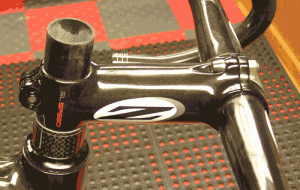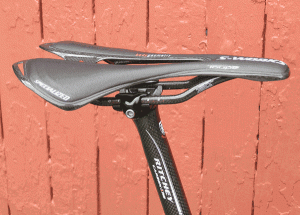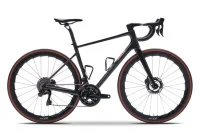Ultralight Guru Photon – Installment 5. Bits & Pieces!
by Jim Weaver, Service Manager, Fit Werx VT
STEM, BARS, PEDALS, SADDLE, ETC.
When selecting a bike, particularly a fully-built bike, most people only look at the frame, drivetrain and wheels. However, the other parts of the bike all relate to the direct interface between the rider and the frame. Pedals, handlebars, stem, saddle, seatpost, even bar tape, can have a direct impact on your riding experience, for the better or the worse. So, care should be taken in selecting good components to serve in these vital roles. In this case, weight was a consideration, but not at the notable expense of riding comfort. There are saddles that are nothing more than a narrow piece of carbon fiber, but I wouldn’t want to sit on it for more than a few minutes. We didn’t want any concessions like that, form had to follow function.
For the stem, we decided to go with a carbon fiber design. Carbon stems have the potential to be lighter than alloy stems, but really not much. In fact, our most common full carbon stem is notably heavier than our most common alloy stem, but it is also a fair amount stiffer and does a great job filtering vibration. Designing a strong, reliable, carbon fiber stem that is lighter than many alloy stems is no easy task, thus explaining the relative dearth of pure carbon fiber, lightweight stems on the market today – there are a few, but not many. A number of “carbon fiber” stems are actually alloy stems, wrapped in carbon fiber – which is simply goofy as they are more expensive and heavier than their alloy counterparts with little torsional benefit. We knew we wanted to keep with the carbon theme on this bike though, so we focused on the few full carbon designs worthy of consideration. We have a great deal of experience with Zipp carbon fiber components, from their wheels, through their carbon bars, and carbon stems. Zipp has been making the Zipp 145 carbon fiber stem for a number of years. This is wonderful design, providing great ride quality and feel, but at 135 grams it was too heavy for this bike. Recently Zipp introduced a light-weight, full carbon stem, the Zipp SL Speed. Our 110 mm version weighed in at a svelte 115 grams, with alloy faceplate, hardware and bolts. Yes, there are lighter stems out there, but this seemed to be a part not worth compromising strength on and we wanted to use a component we trusted.
One of the problems with carbon stems is how to secure the faceplate, and more specifically the faceplate bolts. Screwing bolts into threaded carbon fiber is a bit dicey, necessitating strict adherence to the manufacturer’s torque specifications. Go a bit too tight, and you will strip the threads, thus adding another stem to the trash heap, and flushing a lot of money down the proverbial toilet (pure carbon stems are not inexpensive, as stems go). Zipp  solved this problem by reversing the bolt. In other words, it does not thread into the stem, but rather into the alloy faceplate. This makes for a fussier installation, but results in a stronger faceplate attachment, without having to worry about stripping carbon fiber threads out of the stem itself, so much less potential for expletives during installation. Ian has been riding this stem on his Seven 622 SLX, and has found it to be durable, stiff, and comfortable, providing excellent filtration of annoying road vibration.
solved this problem by reversing the bolt. In other words, it does not thread into the stem, but rather into the alloy faceplate. This makes for a fussier installation, but results in a stronger faceplate attachment, without having to worry about stripping carbon fiber threads out of the stem itself, so much less potential for expletives during installation. Ian has been riding this stem on his Seven 622 SLX, and has found it to be durable, stiff, and comfortable, providing excellent filtration of annoying road vibration.
Having chosen a Zipp stem, it seemed only logical to use a Zipp handlebar. Handlebars are no place to skimp or “settle”, or to simply select the lightest thing on the market. The bars, and the saddle, are two of the most important components for rider comfort. Select the wrong bars, and you will be less comfortable on the bike. Carbon fiber offers not only the ability to manufacture bars in a wide variety of shapes and sizes, but also reduced weight. When done well, carbon bars can offer superior vibration damping, resulting in a more comfortable ride. Zipp offers a wide selection of carbon bars, in various shapes, both traditional and “short and shallow”. By way of explanation, in the past, bars generally had a long “reach” (the distance from the top part of the bar where the stem attaches out to where the bar turns downward and the brake lever/shifters are attached). These older designs also provided a deep “drop” (the distance vertically from the top of the bar down to the “drops”). For those of us who are not as flexible as young racer types, going into the “drops” with these bars was a very occasional event, as it was simply too far down. The long reach and drop of bars was often further aggravated by bike manufacturers’ tendency to make their frames long and low in the first place. So, several years ago handlebar makers began to offer “short and shallow” alternatives. These bars reduce both the reach and drop significantly, making the bars much more user friendly to a wider range of riders and have since become by far the dominant handlebar geometry on the market. Zipp offers several bar alternatives in the “short and shallow” vein. Our client likes the feel and shape of the Zipp SL carbon fiber bars, in the “short and shallow” design, and has them on another bike he owns, so that choice came easy. The 40 cm, center-to-center width that fits him weighs 180 grams.
Of course we needed handlebar tape – this bike isn’t about simply getting rid of all weight at the expense of logic and function. So, I took samples of all of the handlebar tape that we had in the shop, weighing the tape and bar end plugs of each. It ended up that Deda is the lightest tape that we stock. Unless someone specifies otherwise, this is the standard handlebar tape that we use at Fit Werx in Vermont, so, it was an easy choice – a high quality, comfortable, durable tape, that is also the lightest.
The other vital point of contact with the bike is the saddle. Get that wrong, and it can make for a long day (or maybe a ve ry short day…). It is one of the most important elements to a bike. As with handlebars, selecting a saddle simply to save weight is a bad idea, if that saddle does not fit properly. We have carried Specialized saddles for a number of years, and have found that their saddles offer a very wide selection of shapes, sizes, and padding options that suit a really wide range of riders. The Specialized Toupe is a popular saddle, due to its shape and weight. Recently Specialized introduced the S-Works Toupe carbon saddle, with carbon rails, a carbon shell, and somewhat minimalistic padding. This saddle weighs 115 grams on our shop scale, and that is VERY light. The relative lack of padding made me think that this saddle would be uncomfortable, but that is not the case. While the saddle is certainly not cushy, and not everyone will like it, it is not uncomfortable, at least not on my short rides with it. The carbon fiber shell flexes with the rider, absorbing road vibration, and reducing the need for extensive padding. All in all, the design works.
ry short day…). It is one of the most important elements to a bike. As with handlebars, selecting a saddle simply to save weight is a bad idea, if that saddle does not fit properly. We have carried Specialized saddles for a number of years, and have found that their saddles offer a very wide selection of shapes, sizes, and padding options that suit a really wide range of riders. The Specialized Toupe is a popular saddle, due to its shape and weight. Recently Specialized introduced the S-Works Toupe carbon saddle, with carbon rails, a carbon shell, and somewhat minimalistic padding. This saddle weighs 115 grams on our shop scale, and that is VERY light. The relative lack of padding made me think that this saddle would be uncomfortable, but that is not the case. While the saddle is certainly not cushy, and not everyone will like it, it is not uncomfortable, at least not on my short rides with it. The carbon fiber shell flexes with the rider, absorbing road vibration, and reducing the need for extensive padding. All in all, the design works.
The saddle of course needs a seatpost. Carbon seatposts, like carbon handlebars, stems, etc., provide isolation from annoying road vibrations and shock. They are also lighter than alloy seatosts. For fit related reasons, the seatpost on our Guru was going to be of the “zero setback” variety. A zero setback seatpost does not allow the seat clamp to flex at all, as it sits directly on top of the post itself, so carbon fiber offers superior ride quality for this type of design as compared to an all-alloy design. We selected the Ritchey WCS carbon seatpost at 160 grams, which we then whittled down to 140 grams by cutting off the excess length that we did not need for this build.
The final point of a rider’s contact with the bike is the pedals, hardly an unimportant component. For a good discussion of pedals and pedaling biomechanics, see the article on our website at https://fitwerx.com/03-pedals-and-biomechanics. Our client has Speedplay Zero pedals on his other bikes and we wanted to keep it the same if possible. The clamping mechanism for Speedplay’s pedal systems are in the cleat, not in the pedal as with many other designs. The pedals look like a circle on a stick, hence the “lollipop” nickname sometimes heard. The pedal and cleat combination offer wide adjustability of fore-aft, side-to-side, and rotational foot positioning. Bearing maintenance is easy, as a lubrication port is provided. The pedal/cleat combination offers a low stack height, and great cornering clearance for the aggressive types. Speedplays are double-sided, so you do not have to flip the pedal over in order to engage your cleat.
Luckily, Speedplay makes an almost ridiculously light version of the Zero called the “Nanogram”. At 130 grams a pair, the Nanogram feature a carbon fiber reinforced thermoplastic body, alloy and titanium metal parts, titanium axle, and three internal bearings – one ceramic bearing, one cartridge bearing, and one needle bearing. Speedplay pedals themselves are some of the lightest to begin with because the clamping spring mechanism is integrated into the pedal. So, to be fair, when looking at weight we have to consider the pedal/cleat combination. The cleats for the Nanograms weigh 29.2 grams each, due to the use of carbon fiber reinforced thermoplastic, for total weight of cleats of 58.4 grams per pair. Cleats and pedals together weigh less than 189 grams, so the whole combination is very light. We pretty much have a bike now!
Next – The Grand Reveal









